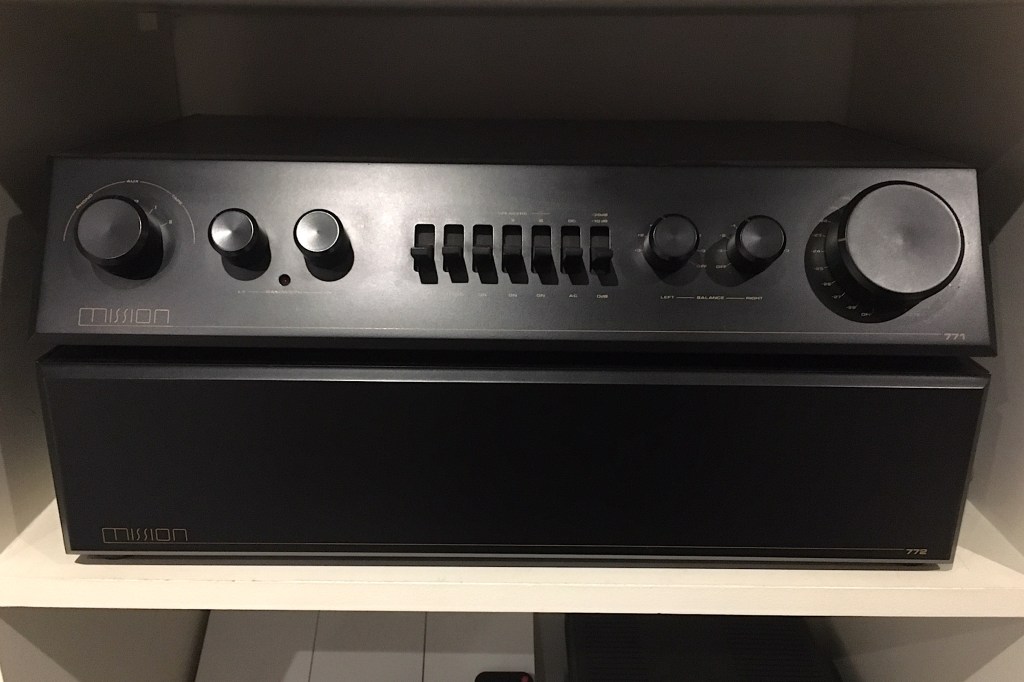Mission Electronics was launched in 1977, with Farad Azima, his brother Henry and Stan Curtis as founder directors. Yet another exciting new British hi-fi company to come out of ‘Silicon Fen’ around Huntingdon, Cambridgeshire – the UK’s equivalent of California’s Silicon Valley you might say – it soon made its mark alongside the likes of A&R Cambridge, Lecson, Meridian, Audiolab and latterly dCS.
Mission’s first product was the bold 770 loudspeaker. The first audiophile design to use a polypropylene drive unit, it was an unconventionally proportioned large two-way standmounting design in a sea of three or even four ways, at that time. It was widely acclaimed and sold well, which would have been enough for many companies, but not this one. Next came the 774 tonearm, said to be the first DC-coupled design, in 1979. The Mission 700 loudspeaker followed soon after, using an inverted drive unit array; retailing for £129 per pair, it was highly successful.
Arguably the company’s most significant products since the 770 were launched in 1980. The 771 preamplifier and 772 power amplifier were a no holds barred high end package, courtesy of Stan Curtis. The former was unusual in design, and built around complex discrete operational amplifier circuit blocks. The latter was a development of Lecson’s ill-fated AP4 Class A power amplifier, but with a Class AB output stage based around three cascode pairs of MJ4502/MJ802 power transistors, according to Curtis. Inside its large aluminium case were a pair of monoblocks, sharing a vast Holden & Fisher toroidal transformer and a pair of large Sprague computer grade capacitors.
“As I recall, this amplifier was good for about 160 watts per channel into 8 ohms and something like 250 watts per channel into 4 ohms”, recalled Curtis. “This product was launched at the Harrogate Audio Fair where the prototype featured a novel feedback system which largely mitigated the effects of the loudspeaker cables. A third cable was wired to the loudspeaker terminals and fed back a signal to the amplifier. It was easy to hear it working but the idea was dropped for production as being too complex for the average buyer of the time.”
The 771 preamp was no stranger to innovation, either. The left hand input selector switched between moving coil, moving magnet, two auxiliary inputs and two tape inputs. Beside it, were low frequency and high frequency bandwidth controls. “The three positions selected different settings which controlled the overall frequency response of the system”, said Curtis. “The row of toggle switches switched two tape positions; stereo-mono; three loudspeaker outputs (switched by relays inside the power amplifier; DC or AC coupling and a gain switch (10dB or 20dB cut) to ensure the volume control always operated in its most linear range.” Balance and volume controls completed the picture.
Both the 771 and 772 were seriously over-engineered; the former had multiple loading options for pickup cartridges, and the latter three sets of speaker terminals. Because the 772 could draw so much current, the usual power fuse was replaced by a large contact breaker positioned above the power cable on the rear panel. This combination formed the basis for all the Mission amplifiers that followed, stretching right up to the Mission Cyrus range of the mid nineteen eighties. It was very well reviewed at the time, and celebrated as true cost-no-object British high end; the latter was certainly true, as a new pair of these would set you back the best part of £1,500 – around five times the price of a new Linn LP12 turntable.
Although praised for its clean, powerful and spacious sound, the 771/772 didn’t have long to win friends and influence people. It was soon replaced by an even more daring design, the Mission 776/777 pre/power combination of 1982. The 777 broke with Mission tradition by using paralleled complementary FET output devices instead of bipolar transistors. A shunt feedback DC-coupled design, there were no capacitors in the direct signal path. Stan Curtis explained that, “this meant that there could be the problem of a DC offset voltage appearing across the loudspeakers. This was minimised by careful selection of several resistors in the factory, but the setting assumed that the output resistance of the preamplifier would be that of the 776. Install a different pre-amp. and you could have unacceptable voltages across the loudspeakers.” The result was that you could only use the 777 with the 776. The brutalist diecast alloy front fascias were as dramatic to look at, as this pre-power was to listen to.
This was discontinued in 1984, to be replaced by the far smaller and simpler Mission 778 integrated, which itself formed the basis of the Mission Cyrus 2 – which ran all the way into the early nineteen nineties. Meanwhile, in the same year the company launched its first Compact Disc player, and by the late eighties and early nineties Mission was king of budget loudspeakers – with the 760 being the best selling loudspeaker in the United Kingdom for nearly four years. By the late nineties, the 771 and 772 numbers were now the names of Mission loudspeakers, and the amplifiers that once shared them were ancient history.

